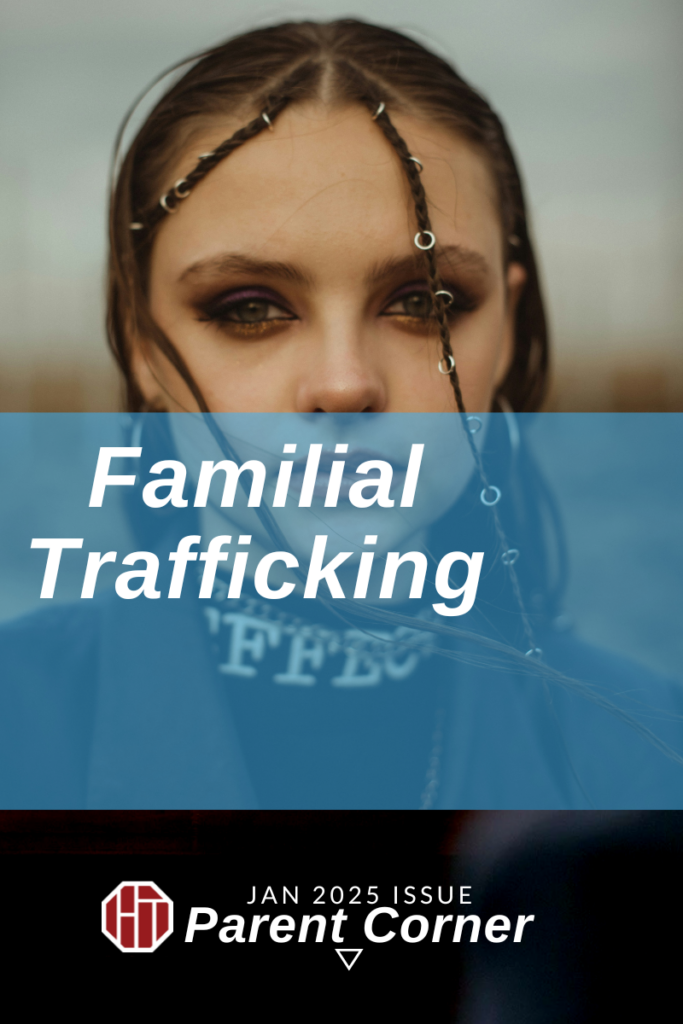Dear Parents,
I hope you had a lovely holiday season with those most dear to you! Here at In Our Backyard,
we have enjoyed reflecting on this last year and all that came with it.
We are back at it this January, looking for opportunities to advocate, learn, and protect those in our own backyard from trafficking. For this edition of The Parent Corner, we are talking about a part of human trafficking that is
easily missed, but very common.
Most people think that people are kidnapped, taken, or coerced into trafficking by strangers.
And many times this is true (see November’s issue). But did you know that between 37-41% of child trafficking situations are occurring within families (International Organization of Migration, 2017) (In Harm’s Way, How Systems Fail Human Trafficking Survivors, 2023)
FACTS ABOUT TRAFFICKING WITHIN FAMILIES – Did you know?
24% of those trafficked are controlled by psychological abuse, 16% are controlled through physical abuse, 10% by sexual abuse, and 9% by psychoactive substances.
68% are trafficked for forced labor and 36% are trafficked for sexual exploitation.
72% of those controlled are female
9% of adults who are trafficked are controlled by their family members. Many of these are disabled adults or those with vulnerabilities that put them at risk. Many of us gathered around the table with family for the holidays. Can you believe that 40 out of 100 trafficked victims in the United States are controlled by family or caregivers?
Elizabeth Frazier was trafficked at first by her parents, but her exploitation continued into her early twenties by others as well.
Here is a small piece of her story: “I endured severe abuse for 20 years. I was also sexually trafficked. The earliest memory I have
of being sold for sex was 4. As a child, I didn’t realize how wrong those things were. I was told I was special and loved, but love was used as a weapon to keep secrets. I was threatened with many things, but losing the love of my parents was threat enough to keep me quiet as a child. I didn’t want to be the one to destroy my family. “
–(Frazier) -Adira Snow, a survivor of familial trafficking, gave this heart-wrenching warning.
- “Adults really need to pay attention because for familial trafficking victims, teachers and medical staff are the first line of defense,” said Adira.
- “I went to school throughout my entire
trafficking situation. I felt like they should have picked up on signs from me like malnutrition,
unexplained absences, lack of understanding of how to interact or play with kids my own age,
constant bruises, and marks.”
Here are a few things to consider. If the family controls victims, it makes them much less likely to escape and find healing. A study published in the Journal of Crime and Justice found that those being trafficked by their families are much less likely to run away due to loyalty and complicated relationships with their controllers. (Reid et. al, 2014) Another study found that familial trafficking victims were consistently less likely to testify and cooperate in investigations. (Allert, 2021) Frequently, these cases occur in families who have experienced generational trauma. Many of those who have experienced familial trafficking struggle with recovery and find
themselves in other abusive and vulnerable positions throughout their life.
Here is an account of a survivor from the First National Survivor Survey.
“In my situation, I was trafficked as a child, then as an adult after not having help in healing
through what I went through. I was domestically trafficked but didn’t realize that till 20 years
later. A family put up an ad for childcare. I would be a live-in nanny. Get paid room and board.
Expected to work 40 hours a week for three kids, unpaid. I was only allowed to shower two
times a week, etc. And expected to get a job outside the house to earn any money for my food,
etc. Due to what I’d gone through being sexually trafficked as a child, I didn’t realize I was being
re-exploited as an adult.”
Friends, please listen in. Families in our neighborhoods and in our own backyards are living in the middle of this type of trauma, whether we see them or not. Let’s open our eyes to see.
With hope for a better future for our kids,
Gina
References:
Allert, J. L. (2021). Justice professionals’ lens on familial trafficking cases. Criminal Justice
Review, 47(2), 208–224. https://doi.org/10.1177/07340168211024719
Daborowski, K. (2023, August 8). Uncovering familial trafficking: Adira James’s story. National
Center for Missing & Exploited Children. https://www.missingkids.org/blog/2023/uncovering-
familial-trafficking
Frazier, E. (n.d.). My story: Hero bands: Sex trafficking: Survivor: Elizabeth Frazier. Hero Bands.
https://herobands.com/pages/my-story
International Organization of Migration . (2017). (rep.).
https://www.iom.int/sites/g/files/tmzbdl486/files/our_work/DMM/MAD/Counter-
trafficking%20Data%20Brief%20081217.pdf.
Polaris. (2023). (rep.). In Harm’s Way How Systems Fail Human Trafficking Survivors. Retrieved
from https://polarisproject.org/wp-content/uploads/2023/07/In-Harms-Way-How-Systems-
Fail-Human-Trafficking-Survivors-by-Polaris-modifed-June-2023.pdf.
Reid, J. A., Huard, J., & Haskell, R. A. (2014). Family-facilitated juvenile sex trafficking. Journal of
Crime and Justice, 38(3), 361–376. https://doi.org/10.1080/0735648X.2014.967965

